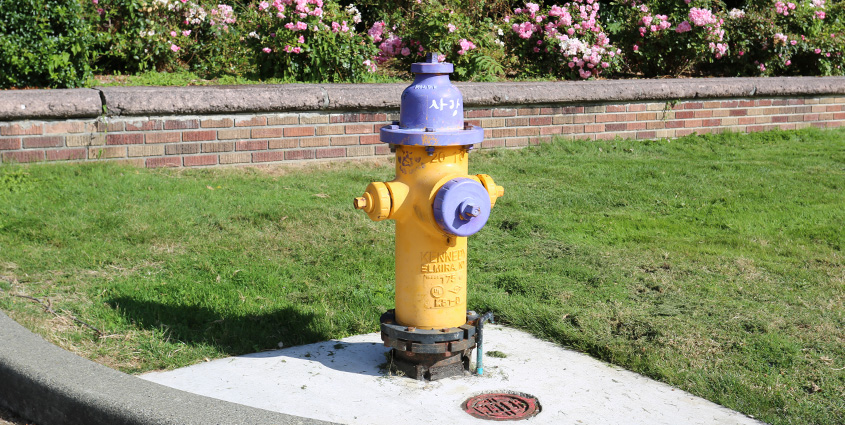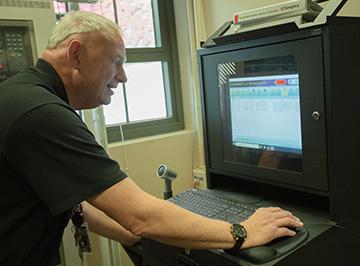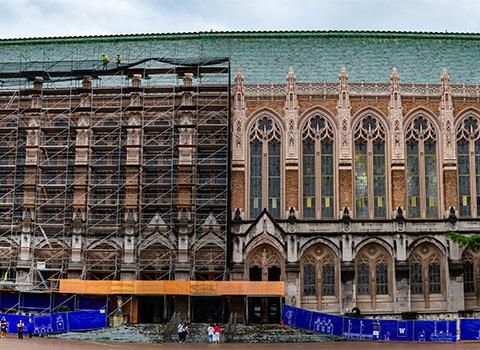Who painted the purple-and-gold fire hydrants?

No one knows who painted the purple-and-gold fire hydrants on campus.
If you’re walking on campus near the HUB or the Quad, you may do a double take at some of the fire hydrants. Painted in purple and gold, they might seem like a fun expression of school spirit. They’re also all painted the same shades, suggesting that one person or group is painting them all.
But no one knows who painted the fire hydrants. Not the fire protection or paint shops in UW Facilities, not the Seattle Fire Department — not even University Marketing and Communications, the group responsible for most of the big banners and signs around campus.
It’s important to find out who is painting them because there are impacts beyond Husky pride, according to UW Fire Protection Shop Manager Brent Almond.
If you have any tips about the purple-and-gold fire hydrants, email them to mistysr@uw.edu.
“Fire hydrants are color-coded to let the firefighters who are responding to an emergency know the gallons per minute that can come out of the hydrant,” he said. “So if you're a firefighter and you see a hydrant that's painted, you could get the wrong impression of what that particular fire hydrant could help with for fighting a fire.”
It’s also not clear how the hydrants are being painted. If the caps are painted closed, for example, firefighters might have a harder time removing the caps or activating the hydrant, Almond said.
So who’s painting the fire hydrants? One guess is that students are the culprit, but the staff at UW Student Life don’t know either.
“I'm concerned that we don't know who is doing it,” said Almond, who is hoping this story will help reveal who is responsible and convince them to stop doing it. He’s not opposed to purple-and-gold fire hydrants as long as the Seattle Fire Department is in the loop.
First line of defense
First line of defense
The UW’s 210 hydrants (whatever their color) are just one part of the large and complicated fire protection system that keeps the University safe. There are 400 buildings on the Seattle campus and 15 million square feet of usable space, so ensuring everything is up and running is no simple task.
The UW’s fire protection shop, part of UW Facilities, handles the inspection, testing and maintenance of campus fire alarms, sprinklers and fire extinguishers. The shop works closely with the Seattle Fire Department, which of course can only do its job if campus fire alarms are working. The sprinklers and fire extinguishers that the shop maintains are also the first line of defense when stopping a fire from getting worse.
You might be surprised about the number of fires on campus, said Ed Sedlak, who handles code compliance for the fire protection shop. “It’s a city of 50,000 people.”
Sedlak, who has worked at the UW for more than 37 years, is part of a team that makes sure that fire protection systems in new buildings comply with local fire codes, a sizable responsibility considering all the construction taking place on campus. And it’s not only new buildings that need to be taken into consideration. With so many buildings from different eras, there are systems that need to be updated, a massive effort that the team is in the process of doing.
The fire protection shop also conducts routine testing on over 89,000 fire alarm devices, over 300 fire suppressions systems and over 7,000 fire extinguishers across campus. It also responds to issues, with 24-hour on-call service. Issues can range from the mundane, such as a dirty smoke detector, to more unique events.
Control technician Geoff Hallett, who has been at the UW for 15 years, remembers when students played dodgeball and broke a sprinkler. Another time, students used a sprinkler as a coat rack. The most common event to set off a fire alarm? Students burning popcorn in the microwave.
Another event Hallett remembers is when a water main in University Village burst, activating the alarms for the sprinklers, but not the sprinklers themselves, in 20 campus buildings. Fire trucks converged upon campus. It was chaotic, but the good news is the alarms worked like they were supposed to.
Mass notification system
Mass notification system
The UW's fire protection systems are linked across campus — making up the largest fire alarm network on the West Coast. In the past, the alarm systems were connected through phone lines but were then upgraded as technology has advanced. In the future, everything will be wireless.
The team monitors this system. It also services and maintains a mass notification system for use in the event of a fire, natural disaster or mass shooter. The UW Police Department can turn on the fire alarm speakers in over 170 buildings and can communicate a message over speakers or message boards in those buildings. While the system gets tested regularly, the UW has fortunately not needed to use it in the 12 years since it was installed.
All this work is in the name of the fire protection shop’s core mission to protect life and property.
Almond has worked in a fire marshal’s office, so he’s seen what can happen if fire protection systems aren’t maintained or kept in compliance.
“[When that happens] a fire department won't be alerted about a fire until they see flames or smoke coming outside of the building,” he said. “With the way we keep our systems, the fire department is alerted as soon as smoke is detected. I'm glad I work at a place that really puts attention into the life and safety of the students and faculty. And that's why the guys are so passionate about what they do — because they know what they do makes a difference for everybody here.”
So next time you see a purple-and-gold fire hydrant, think about the role it plays in the complex system that keeps campus safe. Sometimes the best way to show school spirit is to keep the purple and gold paints at home.





